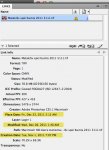Magnus
Well-known member
Since we started using Indesign CS 5.5 a few weeks ago we have had some weird stuff going on with clipping paths.
The last error was when we updated the links in a document from a customer and a photoshop clipping path in a tif-file was suddenly activated and this unfortunately caused a reprint.
Have anyone else had this or a similar problem?
(we are running OSX)
The last error was when we updated the links in a document from a customer and a photoshop clipping path in a tif-file was suddenly activated and this unfortunately caused a reprint.
Have anyone else had this or a similar problem?
(we are running OSX)














